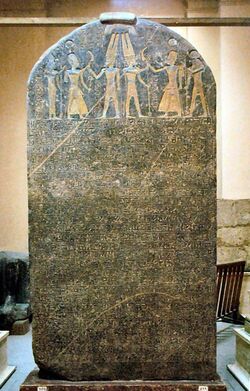Merneptah Stele
The Merneptah Stele – also known as the Israel Stele or the Victory Stele of Merneptah – is an inscription by the ancient Egyptian Pharaoh Merneptah (reign: 1213–1203 BCE) discovered by Flinders Petrie in 1896 at Thebes, and now housed in the Egyptian Museum in Cairo.
The text is largely an account of Merneptah's victory over the Libyans and their allies, but the last 3 of the 28 lines deal with a separate campaign in Canaan, then part of Egypt's imperial possessions:
- The princes are prostrate, saying, "Peace!"
- Not one is raising his head among the Nine Bows.
- Now that Tehenu (Libya) has come to ruin,
- Hatti is pacified;
- The Canaan has been plundered into every sort of woe:
- Ashkelon has been overcome;
- Gezer has been captured;
- Yano'am is made non-existent.
- Israel is laid waste and his seed is not;
- Hurru is become a widow because of Egypt.
The stele represents the earliest textual reference to Israel and the only reference from ancient Egypt. It is one of four known inscriptions, from the Iron Age, that date to the time of and mention ancient Israel, under this name, the others being the Mesha Stele, the Tel Dan Stele, and the Kurkh Monoliths.
